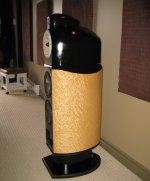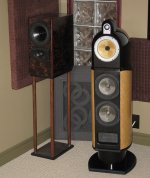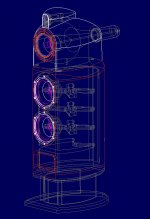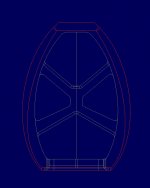Gentlemen, I've tried an elliptical bass cabinet design and had nothing but grief unfortunately. Number is cabinet rigidity. My box has very bad resonance in around 65 Hz and 130. It's almost unlistenable. This could also be contributed to the elliptical shape. MDF was the material I used. I would suggest high quality plywood for the inner bracing. See attached images..








Last edited:
Gentlemen, I've tried an elliptical bass cabinet design and had nothing but grief unfortunately. Number is cabinet rigidity. My box has very bad resonance in around 65 Hz and 130. It's almost unlistenable. This could also be contributed to the elliptical shape. MDF was the material I used. I would suggest high quality plywood for the inner bracing. See attached images..
65 and 130Hz seem pretty low for acoustical resonances, based on a guess of the cabinet dimensions. Are you talking about mechanical cabinet (panel) resonances)?
David
I'm not 100% sure what is resonating exactly but I have tried two different woofers and get the same results. The outside surface of the cabinet resonate at moderate sound levels to the touch. The front baffle is fairly thick and not allowing for good venting as well. I wonder if that can be a contributing factor.. The inner cavity dimension is 13" deep by 8.5" wide (looking from the top). I've had these woofers in a rectangular cabinet before - 13.5" deep by 6.5" wide and had much better results. Reason why I'm blaming the geometry.
The 65 and 130 Hz was measured with a SPL meter and incremental frequency sweep. The next octave, at around 260 Hz, also jumps up on the meter. I've tried them in different rooms, results are the same.
The next step I was thinking on doing was to play with the acousta-stuf inside placement but I doubt it'll make much difference. I'm even considering applying those resonance defeating poly vinyl stick on panels. The ones used for car panels.
The 65 and 130 Hz was measured with a SPL meter and incremental frequency sweep. The next octave, at around 260 Hz, also jumps up on the meter. I've tried them in different rooms, results are the same.
The next step I was thinking on doing was to play with the acousta-stuf inside placement but I doubt it'll make much difference. I'm even considering applying those resonance defeating poly vinyl stick on panels. The ones used for car panels.
Last edited:
Good looking speakers! The elliptical shape should actually be better than a plain box when it comes to rigidity, as long as it's got relatively thick panels. As I was told earlier on in the post, your point-to-point might not be as effective as it looks. Full lenght boards might do a better job.
Quite right about the distance, I just had to point out the edge... I'll see what I can come up with when I get home from Christmas at the parents', but have a hard time seeing how I can round the top and still have a design I like.
What effect does a high woofer have? I sorta figured a higher placement would mean less interaction with the floor, but suddenly got a nasty feeling I'm wrong...
bear said:the distance between the tweet and the edge is many many wavelengths away so the diffraction that does occur will be delayed in time and be uncorrelated - may still have an effect tho. but imo way better design overall... the height of the woofer above the floor surface is of significant concern... so yes the top edge ought to be "taken care of" too...
Quite right about the distance, I just had to point out the edge... I'll see what I can come up with when I get home from Christmas at the parents', but have a hard time seeing how I can round the top and still have a design I like.
What effect does a high woofer have? I sorta figured a higher placement would mean less interaction with the floor, but suddenly got a nasty feeling I'm wrong...
benlalonde,
Disclaimer: I have no idea what I'm talking about as I've never built a speaker so what I'm about to say is likely to make me look really stupid.
Out of curiosity, is the chamber panel or sandwich construction (looks like panel). Would there be any benefit to extending the horizontal bracing to the rear panel? If it is panel resonance then why wouldn't you expect the vinyl panels to help? They'd add rigidity and would also absorb some of the energy thrown at them.
I read once that internal bracing is most effective at dealing with frequencies below 500 Hz and as your resonance frequencies are below that, my cro mangnan understanding of speaker construction instantly tells me that, "ugh, need more bracing", specifically to the back of the enclosure as, right now, that's a pretty large subsection of un-reinforced enclosure (though I'd guess that would be less of an issue with sandwich construction).
Anyways, if you've already explored all of the usual suspects (more internal bracing, adding rigidity to the interior with glue or vinyl panels, etc) what about some other, more esoteric, places to look, like...
Your bass port is nearly as large as the front baffle (width wise). Could the thin walls of the baffle in that area be flexing and transmitting it's own resonance into the rest of the enclosure?
Could part of the problem be the speaker stands? They appear to be the lightest part of the whole unit and so they probably don't provide a great deal of lateral support (put on a back panel and add sand?)
Please note that I'm having a hard time accepting that the elliptical shape of the enclosure is the issue. My understanding (though limited) is that all enclosures have several resonance frequencies. The fact that your cabs resonate at 65/130 physically means (to me) that something in the construction isn't quite right.
I'm also curious, does it's resonance change remarkably if you cap the bass port?
Cheers,
Dave.
Disclaimer: I have no idea what I'm talking about as I've never built a speaker so what I'm about to say is likely to make me look really stupid.
Out of curiosity, is the chamber panel or sandwich construction (looks like panel). Would there be any benefit to extending the horizontal bracing to the rear panel? If it is panel resonance then why wouldn't you expect the vinyl panels to help? They'd add rigidity and would also absorb some of the energy thrown at them.
I read once that internal bracing is most effective at dealing with frequencies below 500 Hz and as your resonance frequencies are below that, my cro mangnan understanding of speaker construction instantly tells me that, "ugh, need more bracing", specifically to the back of the enclosure as, right now, that's a pretty large subsection of un-reinforced enclosure (though I'd guess that would be less of an issue with sandwich construction).
Anyways, if you've already explored all of the usual suspects (more internal bracing, adding rigidity to the interior with glue or vinyl panels, etc) what about some other, more esoteric, places to look, like...
Your bass port is nearly as large as the front baffle (width wise). Could the thin walls of the baffle in that area be flexing and transmitting it's own resonance into the rest of the enclosure?
Could part of the problem be the speaker stands? They appear to be the lightest part of the whole unit and so they probably don't provide a great deal of lateral support (put on a back panel and add sand?)
Please note that I'm having a hard time accepting that the elliptical shape of the enclosure is the issue. My understanding (though limited) is that all enclosures have several resonance frequencies. The fact that your cabs resonate at 65/130 physically means (to me) that something in the construction isn't quite right.
I'm also curious, does it's resonance change remarkably if you cap the bass port?
Cheers,
Dave.
Last edited:
You ain't stupid, Dave! Or maybe I'm just too stupid myself to realize it 😛
I agree with you on adding bracing and extending it to front and back, but I have a sneaking suspicion it'll be difficult to get in there now. Definitely worth a try if it's at all possible. I'd also recommend adding braces between the back wall and woofer magnets.
From what I can see the port is probably one of the strongest areas. There is actually no baffle to resonate there, and it's got a nice, thick brace on top of it.
I share your concern regarding the stand. It's probably the easiest thing to fix, so I'd recommend you start with that.
I'd also recommend the simple solution of adding spikes. A large, flat stand sitting directly on carpet pretty much leaves the whole speaker free to resonate regardless of how rigid it is.
I agree with you on adding bracing and extending it to front and back, but I have a sneaking suspicion it'll be difficult to get in there now. Definitely worth a try if it's at all possible. I'd also recommend adding braces between the back wall and woofer magnets.
From what I can see the port is probably one of the strongest areas. There is actually no baffle to resonate there, and it's got a nice, thick brace on top of it.
I share your concern regarding the stand. It's probably the easiest thing to fix, so I'd recommend you start with that.
I'd also recommend the simple solution of adding spikes. A large, flat stand sitting directly on carpet pretty much leaves the whole speaker free to resonate regardless of how rigid it is.
Dave,
The base cabinet is constructed out of layered 1" MDF machined with CNC. Perhaps next time, if feeling adventurous enough, will try steamed and folded board. Like B&W's method of cabinet making.
The port is aperiodic, to let the cabinet breath only a little. The bracing in that area is quite good since it's a solid board just above it. For the stands, that's a possibility. I made them out of thin sheets of Lexan so that I could fold them in that shape and to house the crossover components (bass cabinet is decoupled from stand with rubber pads). However I have since remove the passive components and now using an active crossover to control all 3 ways.
When I plug the port, there is little change. Perhaps a db or 2 less of bass. Not enough to make an impact.
What I am considering is adding a low pass inductor to the lower woofer in order to taper the bass and possibly lower the interaction between the 2 and cabinet. I believe this will help as I've done this in my previous project with good success. That and trying out a tripod like stand with little surface contact. You did bring up a good point about the stands.
The base cabinet is constructed out of layered 1" MDF machined with CNC. Perhaps next time, if feeling adventurous enough, will try steamed and folded board. Like B&W's method of cabinet making.
The port is aperiodic, to let the cabinet breath only a little. The bracing in that area is quite good since it's a solid board just above it. For the stands, that's a possibility. I made them out of thin sheets of Lexan so that I could fold them in that shape and to house the crossover components (bass cabinet is decoupled from stand with rubber pads). However I have since remove the passive components and now using an active crossover to control all 3 ways.
When I plug the port, there is little change. Perhaps a db or 2 less of bass. Not enough to make an impact.
What I am considering is adding a low pass inductor to the lower woofer in order to taper the bass and possibly lower the interaction between the 2 and cabinet. I believe this will help as I've done this in my previous project with good success. That and trying out a tripod like stand with little surface contact. You did bring up a good point about the stands.
You ain't stupid, Dave!
Don't say that, it's just going to go to my head 🙂
Dave,
The base cabinet is constructed out of layered 1" MDF machined with CNC.
Out of curiosity, how thick are the cabinet walls and are they of uniform thickness? (This is more for my info than anything; I've considered doing a stacked-wood/sandwich cabinet and am interested to hear what dimensions you've used).
I fell in love with the technique when I saw these: Trans-Laminated DIY Speakers - AudioJunkies
Of course, the walls on his cabinet look to be about 2.5" thick and are made of birch ply; not cheap.
Perhaps next time, if feeling adventurous enough, will try steamed and folded board. Like B&W's method of cabinet making.
I'm on the fence with that one. MDF is supposedly sonically dead (I don't think it is, but according to the web, I'm alone in that opinion); not so with ply. I'm still trying to do the mental gymnastics on using the ply.
Because the pressure, overall, is acting against the grain of the wood, I'd imagine that it's going to make a fantastic container for the pressure. But by the same token, ply is fibrous meaning that it's going to resonate like an SOB if you don't give it loves of bracing to absorb the energy and/or some energy absorption agents.
I've spent many a night lying awake dreaming up cockamamie schemes for that method, none of which, I'm sure, would ever work in practice. 🙂
For the stands, that's a possibility. I made them out of thin sheets of Lexan so that I could fold them in that shape and to house the crossover components (bass cabinet is decoupled from stand with rubber pads).
This sounds like a job for a CNC, glue, clamps, lead pellets and a touch of sand. 🙂
What I am considering is adding a low pass inductor to the lower woofer in order to taper the bass and possibly lower the interaction between the 2 and cabinet.
You lost me with this one. Have you removed the second speaker, top or bottom, and capped the opening to see if interaction is your problem (I'm not sure that just disconnecting it would be enough; I have no experience with this)?
Again, I have no practical knowledge here, but I wouldn't think that they would as long as they were in phase/time aligned. If they were slightly out of phase, sure. *shrug*
Cheers,
Dave.
Sounds like a cavity resonance... try stuffing it fairly heavily with polyester fiberfill and see what that does to the resonances? Not saying that this is a good "fix", just a diagnostic tool. Might not work, since there isn't much dimension for the poly fill to do it's thing at those low freqs...
Also, have you measured the freq response just from the port? (put the mic a few inches back)
And, do you have ANY absorptive material inside the cabinet?
_-_-bear
Also, have you measured the freq response just from the port? (put the mic a few inches back)
And, do you have ANY absorptive material inside the cabinet?
_-_-bear
I'm on the fence with that one. MDF is supposedly sonically dead (I don't think it is, but according to the web, I'm alone in that opinion); not so with ply. I'm still trying to do the mental gymnastics on using the ply.
You are not alone.
http://www.diyaudio.com/forums/cons...rials-build-speakers-out.html?highlight=build
dave
Sounds like a cavity resonance... try stuffing it fairly heavily with polyester fiberfill and see what that does to the resonances? Not saying that this is a good "fix", just a diagnostic tool. Might not work, since there isn't much dimension for the poly fill to do it's thing at those low freqs...
Also, have you measured the freq response just from the port? (put the mic a few inches back)
And, do you have ANY absorptive material inside the cabinet?
_-_-bear
Yes, I have played with different amount of acoustic treatment, from heavy fill to light, no change that "I" can here.
I bought a nice Behringer mic months back and only now having time to setup and play with it and ARTA software. My Win7 is not recognizing the mic (of course) and was wondering if it absolutely has to be connected to a preamp then line input to sound card..? Right now it's connected directly (unbalanced) into the mic input. And the "procedures" and parameters to be setup in ARTA ...holy crap! Didn't think it was complicated

What mic is it? If it's a condenser mic, like the ECM8000 "everyone" has, it needs a mic preamp with 15 to 48 V phantom power to do anything at all. I'm afraid I can't help you with ARTA.
Well, if ya change the woofers and the problem in the response remains "it ain't that"!
(unless they are very similar T/S)
But, what do you mean by "resonances"? peaks in the response, or holes in the response, leaving those two freqs high??
Anyhow, consider putting the cabinet UPSIDE DOWN and on the FLOOR, seeing what that does?? I mean the bass cabinet, flip it over, and get it off the stand... report back... also maybe pull it out from the wall by a few feet too...
well, some sort of T/S info and curves would be sweet... it LOOKS like a fine construction job!
_-_-bear
(unless they are very similar T/S)
But, what do you mean by "resonances"? peaks in the response, or holes in the response, leaving those two freqs high??
Anyhow, consider putting the cabinet UPSIDE DOWN and on the FLOOR, seeing what that does?? I mean the bass cabinet, flip it over, and get it off the stand... report back... also maybe pull it out from the wall by a few feet too...
well, some sort of T/S info and curves would be sweet... it LOOKS like a fine construction job!
_-_-bear
What mic is it? If it's a condenser mic, like the ECM8000 "everyone" has, it needs a mic preamp with 15 to 48 V phantom power to do anything at all. I'm afraid I can't help you with ARTA.
Yes, it's the EMC 8000 that everyone has.
I just finished building two 3 channel gainclone amps. Not really into building a mic amp at this point. Can anyone recommend a low cost but decent mic preamp?
Well, if ya change the woofers and the problem in the response remains "it ain't that"!
(unless they are very similar T/S)
But, what do you mean by "resonances"? peaks in the response, or holes in the response, leaving those two freqs high??
Anyhow, consider putting the cabinet UPSIDE DOWN and on the FLOOR, seeing what that does?? I mean the bass cabinet, flip it over, and get it off the stand... report back... also maybe pull it out from the wall by a few feet too...
well, some sort of T/S info and curves would be sweet... it LOOKS like a fine construction job!
_-_-bear
I'm approximating with the help of a SPL meter. I know the room plays a part in this but it's been the same results for EVERY room I've listen them in. I would say they are sympathetic harmonics (or resonance) which the cabinet is amplifying in the low to mid bass. Certainly not flat. Even when I reach in and snap my fingers ...can hear some colored boxy tone. It just occurred to me that the cabinet length could be a player in this as well... Being short, the vertical pressure waves are likely being attenuated at those frequencies.
Something is going on and if I don't get to the bottom of the problem, I'll have to redo the mid bass cabinets.
I'm approximating with the help of a SPL meter. I know the room plays a part in this but it's been the same results for EVERY room I've listen them in. I would say they are sympathetic harmonics (or resonance) which the cabinet is amplifying in the low to mid bass. Certainly not flat. Even when I reach in and snap my fingers ...can hear some colored boxy tone. It just occurred to me that the cabinet length could be a player in this as well... Being short, the vertical pressure waves are likely being attenuated at those frequencies.
Something is going on and if I don't get to the bottom of the problem, I'll have to redo the mid bass cabinets.
65 and 130 Hz are too low for any length related resonance for this size cabinet. You say you reach in? With the woofer removed or through a port? Possibly port upper resonances? Are you sure it isn't the room?
David S.
2 CH Mic/Line Pre + Ph_48V
Please take a look at this simplest one:
M-AUDIO - Audio Buddy - Budget Microphone Preamp
It has anything one need for the all kind of measurements via decent sound card or a good one integrated, only line in and outs are needed & with minimal additional voltage dividers (diy) one can convert
any PC/MAC into powerful all kind audio measuring place. 😉
Cheers
Can anyone recommend a low cost but decent mic preamp?
Please take a look at this simplest one:
M-AUDIO - Audio Buddy - Budget Microphone Preamp
It has anything one need for the all kind of measurements via decent sound card or a good one integrated, only line in and outs are needed & with minimal additional voltage dividers (diy) one can convert
any PC/MAC into powerful all kind audio measuring place. 😉
Cheers
interference and diffraction
after have read jaes papers on the subject, i decided to attach soundabsorbingfoam to the so small made bafflefront ,as is possible.see photo .this will probably solve your problem and will increase sweet-spot and stereo-localisation as well ,even a smoother freq-respons in differeent angle's is the result
after have read jaes papers on the subject, i decided to attach soundabsorbingfoam to the so small made bafflefront ,as is possible.see photo .this will probably solve your problem and will increase sweet-spot and stereo-localisation as well ,even a smoother freq-respons in differeent angle's is the result
Attachments
- Status
- Not open for further replies.
- Home
- Loudspeakers
- Multi-Way
- Elliptical enclosure - reflection/diffraction issues?
![100_0461[1].jpg](/community/data/attachments/188/188802-86faa8237cabc24c0cb74d6831bc750e.jpg?hash=hvqoI3yrwk)